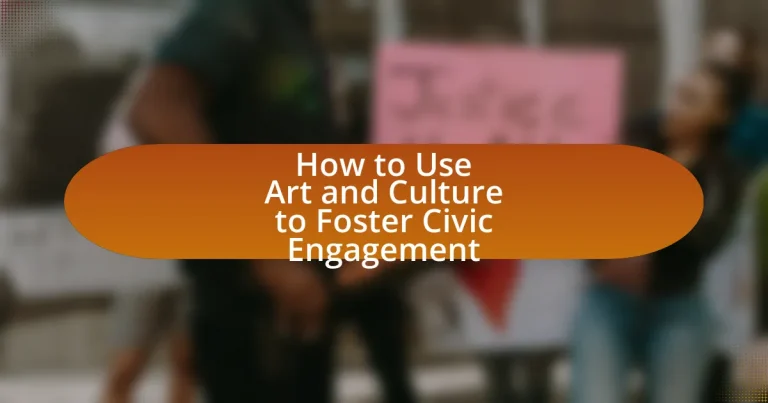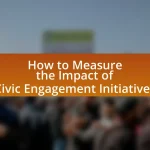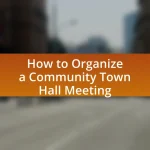The article focuses on the role of art and culture in fostering civic engagement within communities. It highlights how artistic expression enhances community identity, encourages participation in social issues, and correlates with increased civic activities such as voting and volunteering. Key forms of art that promote civic involvement include community murals, public performances, and participatory theater, which facilitate dialogue and collaboration among residents. The article also discusses the importance of cultural events in enhancing civic engagement, the benefits of partnerships between artists and civic organizations, and best practices for implementing art initiatives that effectively engage the community.
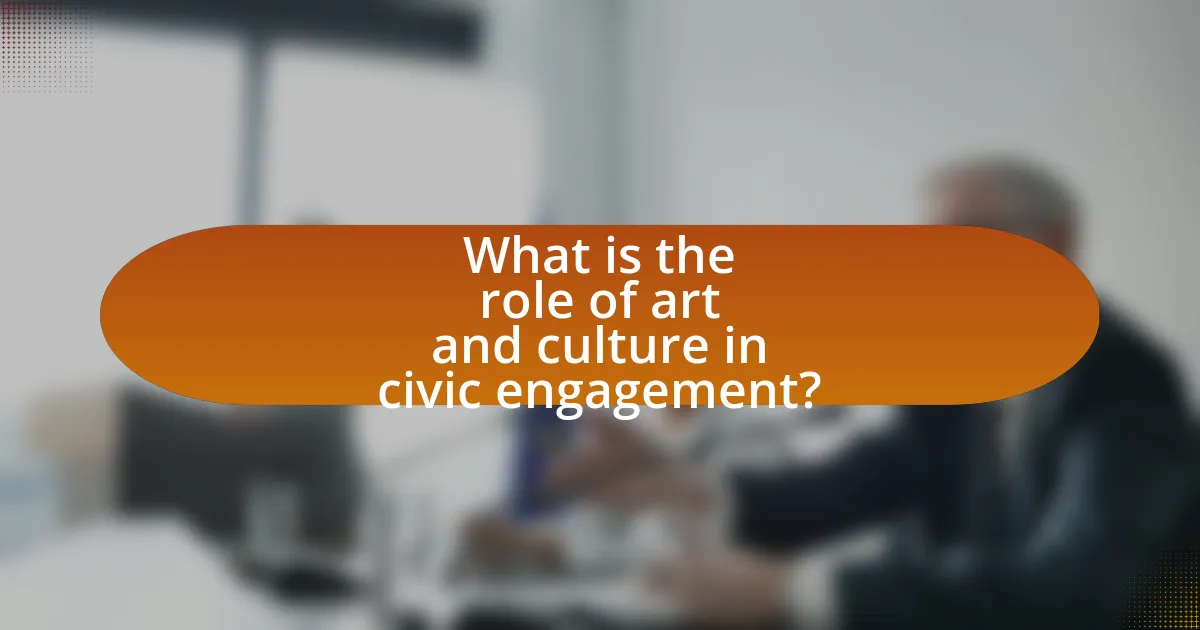
What is the role of art and culture in civic engagement?
Art and culture play a crucial role in civic engagement by fostering community identity and encouraging participation in social issues. Through artistic expression, individuals can communicate their experiences and perspectives, which can mobilize others to engage in civic activities. For instance, public art projects often address local concerns, prompting discussions and actions around community needs. Research indicates that communities with vibrant cultural activities report higher levels of civic participation, as seen in studies by the National Endowment for the Arts, which found that arts engagement correlates with increased voting and volunteering rates. Thus, art and culture serve as powerful tools for enhancing civic involvement and building stronger communities.
How do art and culture influence community participation?
Art and culture significantly enhance community participation by fostering a sense of belonging and shared identity among individuals. Engaging in artistic and cultural activities, such as community festivals, art exhibitions, and performances, encourages collaboration and interaction among residents, which strengthens social ties. Research conducted by the National Endowment for the Arts indicates that communities with vibrant cultural programs experience higher levels of civic engagement, as these activities provide platforms for dialogue and collective action. Furthermore, art serves as a medium for expressing community issues and aspirations, motivating individuals to participate in local governance and initiatives.
What specific forms of art promote civic involvement?
Specific forms of art that promote civic involvement include community murals, public performances, and participatory theater. Community murals engage local residents in the creation process, fostering a sense of ownership and pride in their environment, which can lead to increased civic participation. Public performances, such as street theater or music festivals, create spaces for dialogue and community interaction, encouraging citizens to engage with social issues. Participatory theater invites audiences to become active participants in the storytelling process, often addressing civic themes and prompting discussions about community challenges. These art forms have been shown to enhance social cohesion and motivate individuals to take part in civic activities, as evidenced by various community art initiatives that have successfully mobilized residents to advocate for local issues.
How does cultural expression reflect community values?
Cultural expression reflects community values by serving as a medium through which shared beliefs, traditions, and social norms are communicated and celebrated. For instance, festivals, music, and visual arts often embody the historical narratives and collective identity of a community, reinforcing what members prioritize and cherish. Research indicates that communities with strong cultural expressions, such as public art installations or local theater productions, often exhibit higher levels of civic engagement and social cohesion, as these activities foster a sense of belonging and collective responsibility among residents.
Why is civic engagement important for communities?
Civic engagement is important for communities because it fosters social cohesion and empowers individuals to influence local governance. Engaged citizens are more likely to participate in decision-making processes, leading to policies that reflect the community’s needs and values. Research indicates that communities with higher levels of civic engagement experience improved public services and enhanced quality of life, as seen in studies by the National Civic League, which highlight the correlation between active participation and community well-being.
What are the social benefits of increased civic engagement?
Increased civic engagement fosters social cohesion and enhances community well-being. When individuals participate in civic activities, such as voting, volunteering, or attending community meetings, they build stronger relationships with their neighbors and develop a sense of belonging. Research indicates that communities with higher levels of civic engagement experience lower crime rates and improved public health outcomes, as seen in studies conducted by the National Civic League, which found that engaged communities are more likely to collaborate on local issues and support one another. Furthermore, civic engagement promotes inclusivity and diversity, allowing marginalized voices to be heard and contributing to more equitable decision-making processes.
How does civic engagement contribute to democratic processes?
Civic engagement enhances democratic processes by fostering active participation of citizens in political and community affairs. This participation leads to increased accountability of elected officials, as engaged citizens are more likely to hold them responsible for their actions. Studies show that communities with higher levels of civic engagement experience greater voter turnout, which is crucial for a representative democracy. For instance, the U.S. Census Bureau reported that in 2020, states with robust civic engagement initiatives saw voter turnout rates exceed 80%, compared to lower rates in less engaged communities. This correlation underscores the importance of civic engagement in ensuring that democratic processes reflect the will of the people.

How can art initiatives foster civic engagement?
Art initiatives can foster civic engagement by creating platforms for community dialogue and participation. These initiatives often involve collaborative projects that encourage individuals to express their views and experiences, thereby enhancing social cohesion. For example, public art installations and community murals can serve as focal points for discussions about local issues, allowing residents to engage with one another and with decision-makers. Research by the National Endowment for the Arts indicates that communities with active arts programs report higher levels of civic participation, as these programs often mobilize residents around shared interests and concerns.
What types of art projects encourage civic participation?
Art projects that encourage civic participation include community murals, public art installations, participatory theater, and collaborative art workshops. Community murals engage local residents in the creation process, fostering a sense of ownership and pride in their environment. Public art installations often address social issues, prompting dialogue and reflection among community members. Participatory theater invites audiences to engage actively with performances, often addressing civic themes and encouraging discussion. Collaborative art workshops provide a platform for diverse voices, allowing participants to express their perspectives on community issues. These projects have been shown to enhance social cohesion and empower individuals to take part in civic life.
How do public art installations engage local communities?
Public art installations engage local communities by fostering a sense of belonging and encouraging participation in the creative process. These installations often reflect the cultural identity and values of the community, making art accessible and relevant to local residents. For instance, studies have shown that public art can increase community pride and cohesion, as seen in the “Art in Public Places” program in San Francisco, which has successfully involved residents in the design and implementation of art projects. This participatory approach not only enhances community engagement but also promotes dialogue among diverse groups, ultimately strengthening social ties and civic involvement.
What role do community art programs play in fostering dialogue?
Community art programs play a crucial role in fostering dialogue by creating inclusive spaces where diverse voices can express their perspectives. These programs encourage collaboration among participants from various backgrounds, facilitating conversations that address social issues and community concerns. For instance, research by the National Endowment for the Arts highlights that community art initiatives can enhance civic engagement by promoting understanding and empathy among participants, ultimately leading to stronger community bonds.
How can cultural events enhance civic engagement?
Cultural events enhance civic engagement by fostering community connections and encouraging participation in local governance. These events create platforms for dialogue, allowing individuals to express their views and engage with civic issues in a communal setting. For instance, studies show that communities with active cultural programming experience higher voter turnout and increased involvement in local initiatives, as seen in the National Endowment for the Arts report, which highlights that arts participation correlates with civic activities. By bringing diverse groups together, cultural events promote inclusivity and empower citizens to take an active role in shaping their communities.
What are the most effective types of cultural events for community involvement?
The most effective types of cultural events for community involvement include festivals, art exhibitions, and community theater performances. Festivals, such as local food or music festivals, foster engagement by bringing diverse groups together, promoting local culture, and encouraging participation through interactive activities. Art exhibitions that feature local artists can enhance community pride and provide a platform for dialogue, while community theater performances often involve local talent and can address relevant social issues, thereby encouraging civic participation. Research indicates that these events not only strengthen community ties but also increase civic engagement, as evidenced by studies showing that participation in local cultural activities correlates with higher levels of community involvement and volunteerism.
How do festivals and performances create a sense of belonging?
Festivals and performances create a sense of belonging by fostering community connections and shared experiences among participants. These events often bring together diverse groups, allowing individuals to engage in cultural expressions that resonate with their identities. For instance, studies show that communal activities during festivals, such as parades or collaborative art projects, enhance social cohesion and promote feelings of inclusion. Research conducted by the National Endowment for the Arts indicates that participation in cultural events can lead to increased social capital, as individuals form bonds and networks that strengthen community ties.
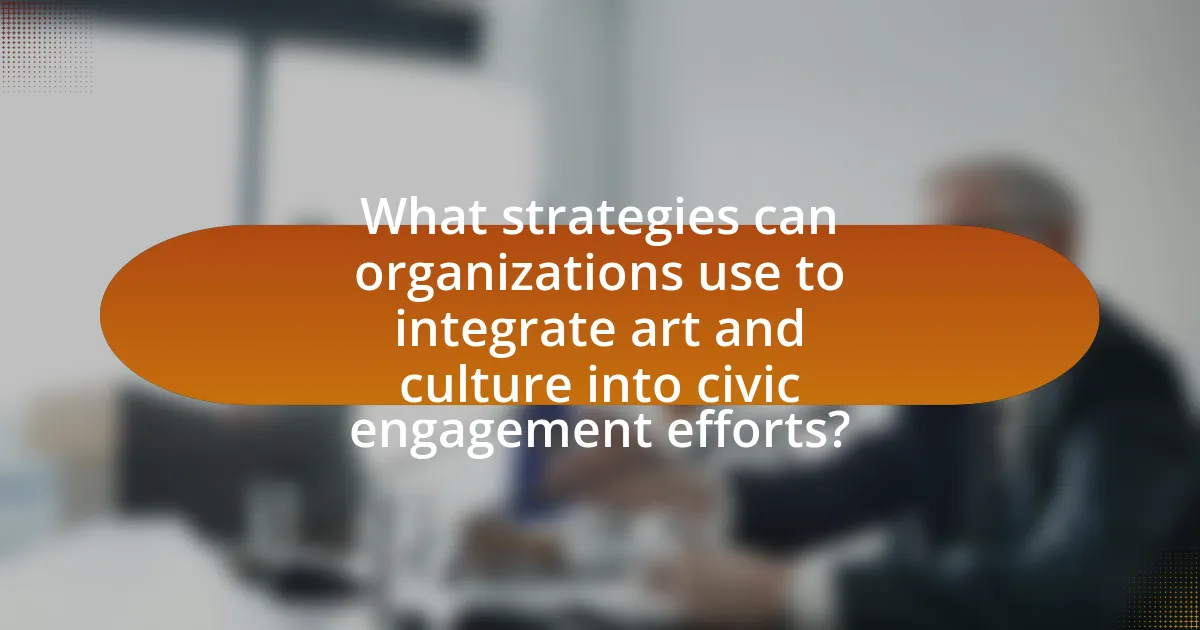
What strategies can organizations use to integrate art and culture into civic engagement efforts?
Organizations can integrate art and culture into civic engagement efforts by implementing community-based art projects that encourage participation and dialogue. These projects can include public art installations, community theater performances, and collaborative mural painting, which foster a sense of ownership and connection among residents. For instance, the “ArtPlace America” initiative has successfully funded projects that blend arts and community development, demonstrating that art can enhance civic identity and participation. Additionally, organizations can host cultural festivals that celebrate local heritage, providing a platform for diverse voices and promoting inclusivity in civic discussions. Research shows that such initiatives not only beautify neighborhoods but also strengthen community ties and increase civic involvement, as evidenced by the National Endowment for the Arts’ findings on the impact of arts engagement on community cohesion.
How can partnerships between artists and civic organizations be formed?
Partnerships between artists and civic organizations can be formed through collaborative projects that align mutual goals, such as community development or cultural enrichment. These partnerships often begin with open dialogues where both parties identify shared interests and resources. For instance, artists can engage with civic organizations by proposing art initiatives that address local issues, while civic organizations can provide platforms and funding for these projects. Successful examples include community mural projects or public art installations that reflect local history, which have been shown to enhance community identity and participation.
What are the benefits of collaboration between cultural institutions and local governments?
Collaboration between cultural institutions and local governments enhances community engagement and promotes cultural development. This partnership allows for the pooling of resources, expertise, and networks, leading to more impactful cultural programs and initiatives. For instance, when local governments support cultural institutions through funding or policy, it can result in increased accessibility to arts and culture for residents, fostering a sense of belonging and community pride. Additionally, studies show that such collaborations can stimulate local economies; for example, a report by the National Endowment for the Arts indicates that arts and culture contribute over $877 billion to the U.S. economy, highlighting the economic benefits of these partnerships.
How can funding be secured for art and culture initiatives aimed at civic engagement?
Funding for art and culture initiatives aimed at civic engagement can be secured through a combination of grants, partnerships, and community fundraising efforts. Government agencies, such as the National Endowment for the Arts, provide grants specifically for projects that enhance civic participation through the arts. Additionally, collaborating with local businesses and nonprofits can create sponsorship opportunities that align with community interests, thereby increasing financial support. Community fundraising initiatives, such as crowdfunding campaigns, can also engage local residents and stakeholders, fostering a sense of ownership and investment in the projects. According to a report by the Urban Institute, community-driven funding models have shown to increase both financial resources and civic involvement in cultural initiatives.
What best practices should be followed in implementing art and culture for civic engagement?
Best practices for implementing art and culture for civic engagement include fostering community participation, ensuring accessibility, and promoting collaboration among diverse stakeholders. Community participation is essential as it empowers individuals to express their perspectives and needs, leading to more relevant and impactful projects. Accessibility ensures that art and cultural initiatives reach a broad audience, including marginalized groups, which enhances inclusivity and engagement. Collaboration among artists, local organizations, and government entities can leverage resources and expertise, creating a more robust framework for civic engagement. Research by the National Endowment for the Arts indicates that community-based art projects significantly increase civic participation and social cohesion, demonstrating the effectiveness of these best practices.
How can feedback from the community improve art initiatives?
Feedback from the community can significantly improve art initiatives by ensuring that the projects align with the interests and needs of the local population. When artists and organizations actively seek input from community members, they can create more relevant and engaging works that resonate with the audience. For instance, a study by the National Endowment for the Arts found that community engagement in the arts leads to increased participation and satisfaction, as projects that reflect community values are more likely to attract diverse audiences. This alignment fosters a sense of ownership and pride among community members, ultimately enhancing the impact and sustainability of art initiatives.
What metrics can be used to measure the impact of art on civic engagement?
Metrics that can be used to measure the impact of art on civic engagement include participation rates in art-related events, surveys assessing community sentiment, and social media engagement metrics. Participation rates provide quantitative data on how many individuals engage with art initiatives, indicating the level of community involvement. Surveys can capture qualitative insights into how art influences civic attitudes and behaviors, revealing shifts in community sentiment towards civic issues. Social media engagement metrics, such as shares, likes, and comments on art-related posts, reflect public interest and discourse, demonstrating how art fosters dialogue around civic matters. These metrics collectively offer a comprehensive view of art’s role in enhancing civic engagement.
What practical tips can organizations use to successfully foster civic engagement through art and culture?
Organizations can successfully foster civic engagement through art and culture by implementing community-based art projects that encourage participation and dialogue. These projects can include public art installations, community theater performances, and collaborative mural painting, which actively involve local residents in the creative process. Research shows that such initiatives not only enhance community cohesion but also empower individuals to express their views and concerns, thereby increasing civic participation. For instance, a study by the National Endowment for the Arts found that communities engaged in arts activities reported higher levels of civic engagement and social cohesion. By prioritizing inclusivity and accessibility in these projects, organizations can ensure diverse voices are represented, further strengthening civic engagement.
